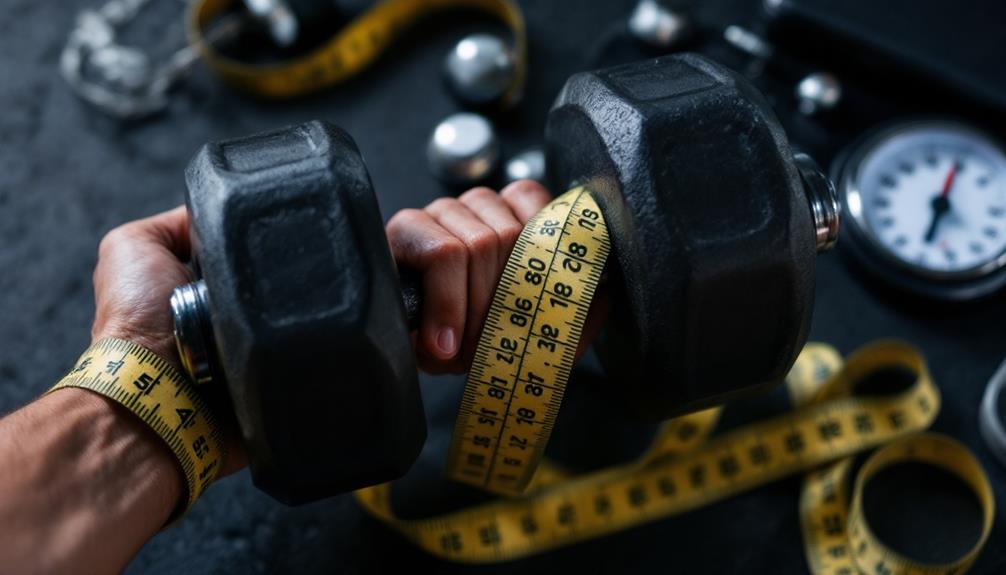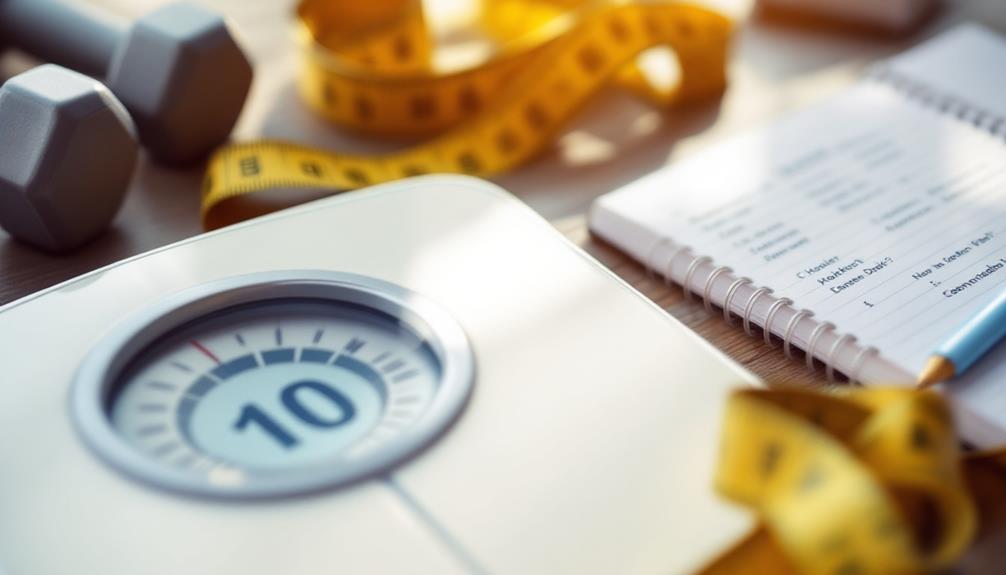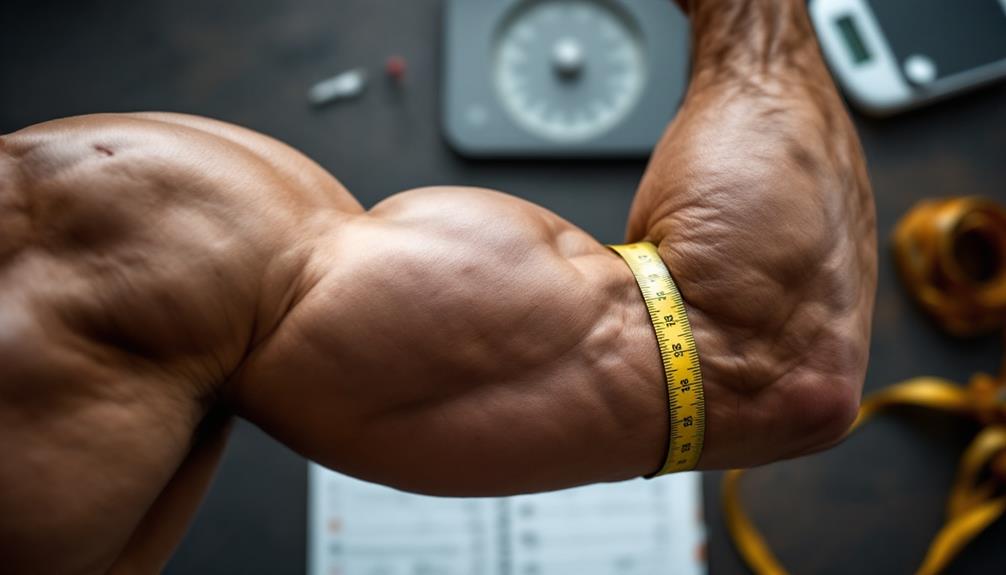To know if you're gaining muscle, follow these steps. First, track body measurements like chest, arms, and thighs monthly. Next, assess strength levels by monitoring your reps and weights. Keep an eye on weight changes, remembering fluctuations are normal. Observe your physical appearance for increased muscle definition and how clothes fit. Evaluate workout performance by tracking weights lifted and intensity. Take consistent progress photos to visualize your growth. Finally, analyze your nutrition intake, ensuring you're eating enough protein and calories. By focusing on these indicators, you'll clearly understand your muscle-building progress and what's next.
Core Insight
- Measure your body dimensions monthly to track increases in muscle size, particularly in the chest, arms, waist, and thighs.
- Monitor your strength levels by recording the weights lifted and repetitions performed to observe consistent progress.
- Take regular progress photos in consistent lighting to visually assess muscle definition and overall appearance changes.
- Check how your clothes fit; tighter clothing in certain areas could indicate muscle gain and fat loss.
- Ensure you are consuming sufficient protein and calories to support muscle growth and recovery in your diet.
Tracking Body Measurements

How can you tell if you're gaining muscle? One simple way is to track your body measurements. Start by measuring important areas like your chest, arms, waist, and thighs. Use a flexible measuring tape to get accurate results. Record these measurements once a month to see how you change over time. Just like vitamin D3 helps with muscle and immune health, tracking your measurements can show you how you're progressing. Regular checks can help you adjust your workout and diet for the best results.
As you continue, you should see your muscle size increase, especially in the areas you've been working on. Taking photos can also help; they give you a visual record that numbers alone might not show.
Remember that you can gain muscle while losing fat, so look at the overall trend in your measurements. By keeping track of these numbers, you'll have a clearer view of your muscle-building journey.
Assessing Strength Levels

Next, pay attention to how many reps you can do. If you can do more reps with the same weight, you are likely getting stronger. It's important to keep track of your progress and set realistic goals for yourself. This will help you stay motivated.
Also, check your form. If you can lift heavier weights while keeping good technique, that's a good sign.
Monitoring Weight Changes

Tracking your weight changes can provide useful insights into your muscle-building journey. To start, weigh yourself regularly, ideally at the same time each day or week. This helps you establish a baseline. Keep in mind that fluctuations are normal due to factors like hydration and food intake, so focus on the overall trends rather than daily changes. For the best results, think about adding high-quality protein sources to your diet, such as organic protein powders, which can help with muscle growth and recovery.
Next, consider using a scale that measures body composition. This will give you a better understanding of how much muscle versus fat you are gaining. Also, keep a log of your weight along with your workout routines and eating habits. This combined approach lets you see how your efforts relate to changes in your weight. Ultimately, recognizing these patterns can help you determine if you're on track to meet your muscle-building goals.
Observing Physical Appearance

While keeping track of your weight is important, noticing changes in how you look can give you a quicker idea of muscle gain. Check how your clothes fit. If they feel snugger in the shoulders, arms, or thighs, that's a good sign that your muscles are growing. Look for more definition in your muscles, like clearer biceps, triceps, or calves.
To help your muscles recover and become more defined, think about adding foam rolling to your post-workout routine. It can boost blood flow and ease soreness.
Taking progress photos can also be helpful. Looking back at these pictures over time can show you small changes that you might not notice day by day. Pay attention to your posture too. Stronger muscles often lead to better posture, making you appear taller and more confident. By focusing on these visual signs, you can effectively track your muscle-building journey.
Evaluating Workout Performance

Regularly checking how you perform in your workouts is important for understanding muscle growth. Start by keeping track of the weights you lift. Are you getting stronger over time? If you're lifting heavier, that's a good sign of muscle development. Next, look at your repetitions. If you can do more reps with the same weight, that's also a positive indicator.
Think about using foam rollers for recovery. They can help improve flexibility and reduce muscle soreness, which may lead to better performance in your workouts.
Pay attention to how long and how hard you're working out. If you're pushing yourself more or exercising longer, it means your body is adapting. Also, check how you feel after your workouts. If you're less tired than before, it shows your fitness is improving.
Taking Progress Photos

One great way to see your muscle growth is by taking progress photos. These pictures can help you compare your physique over time and spot changes that you might not notice every day. Just like with any routine, being consistent is important for getting good results. Here are some simple tips for taking effective progress photos:
- Use the same lighting each time to make changes easier to see.
- Wear the same clothes for every photo to keep things consistent.
- Take pictures from different angles, like the front, side, and back.
- Choose a plain background to keep the focus on you.
- Take photos regularly, such as every 4 to 6 weeks.
Following these tips will help you track your progress more effectively.
Checking Recovery Times
Monitoring how quickly you recover after workouts is important for tracking your muscle growth. When you exercise, your muscles get stressed and need time to heal. If you find that you're recovering faster, it likely means your muscles are getting stronger. Some athletes use natural supplements to help with recovery and overall health during intense training.
To check your recovery times, notice how sore you feel after exercising. Keep a record of how long it takes for that soreness to go away before your next workout. Also, pay attention to your energy levels and how well you perform in your next sessions.
If you feel energized and can lift heavier weights or do more repetitions, your recovery is going well. Keep an eye on these signs, as they will help you measure your progress and make any necessary changes to your training plan.
Analyzing Nutrition Intake

Nutrition is key for building muscle, and it's important to analyze what you eat to improve your results. Here are some simple steps to help you fuel your body effectively:
- Get Enough Protein: Protein is crucial for repairing and growing muscle. Aim for a good amount of protein each day. Protein powders can help, with many providing 20-30 grams of protein per serving.
- Eat More Calories: To gain muscle, you need to eat more calories than you burn. This caloric surplus helps your muscles grow.
- Include Healthy Fats: Don't avoid fats; they are vital for producing hormones that support muscle growth.
- Add Carbohydrates: Carbs give you energy, especially before and after workouts. Make sure to include them in your meals.
- Stay Hydrated: Drink plenty of water. Staying hydrated is important for your overall performance.
Understanding Muscle Soreness

When you push your limits during workouts, tiny tears happen in your muscle fibers. As your body heals these tears, it builds muscle, which is important for growth. However, feeling sore doesn't always mean you're gaining muscle. It can also happen when you try new exercises or increase the intensity of your workouts.
To help your muscles recover and reduce soreness, you might want to add BCAA supplements to your post-workout routine. These supplements can help your body use protein better and prevent muscle breakdown.
To manage soreness, remember to stay hydrated, stretch, and give your body enough time to recover. Listening to your body is crucial for reaching your fitness goals while reducing the risk of injury.
Frequently Asked Questions
How Often Should I Assess My Muscle Gain Progress?
You should assess your muscle gain progress every 4 to 6 weeks. This timeframe allows you to notice changes without becoming overly fixated. Consistency in your workouts and nutrition will also help track your success effectively.
Can I Gain Muscle Without Gaining Weight?
You can gain muscle without gaining weight by focusing on body composition. Strength training, high protein intake, and consistent workouts can help you build muscle while losing fat, leading to a leaner physique without significant weight changes.
What Role Do Genetics Play in Muscle Gain?
Genetics plays a huge role in muscle gain; some folks build muscle easily, while others struggle. You can't change your genes, but you can optimize your training and nutrition to maximize your potential, regardless of your starting point.
Are There Specific Foods That Promote Muscle Growth?
Yes, certain foods can boost muscle growth. Incorporate lean proteins like chicken and fish, complex carbs such as quinoa, and healthy fats from avocados and nuts. These foods fuel your workouts and support recovery effectively.
How Can Stress Affect Muscle Gain?
Stress can hinder muscle gain by increasing cortisol levels, which break down muscle tissue. You might think stress is unavoidable, but managing it through relaxation techniques can help you maintain your gains and overall health.

